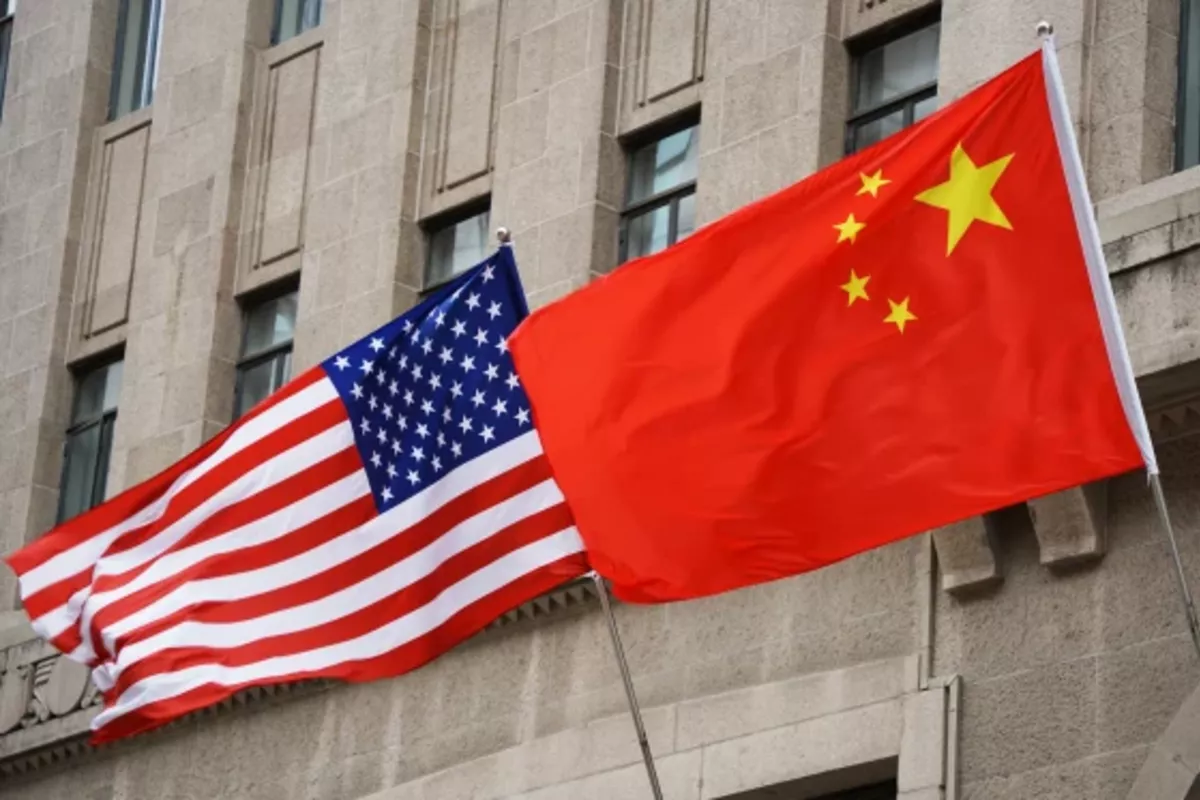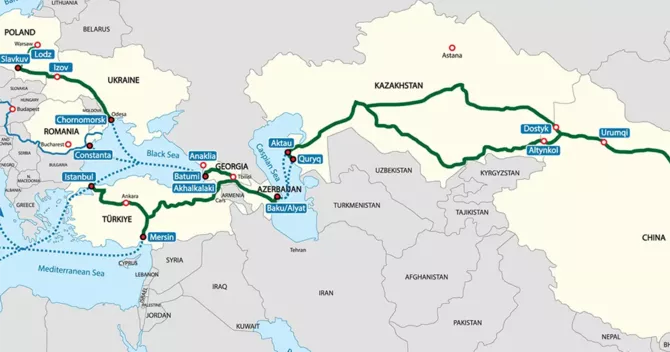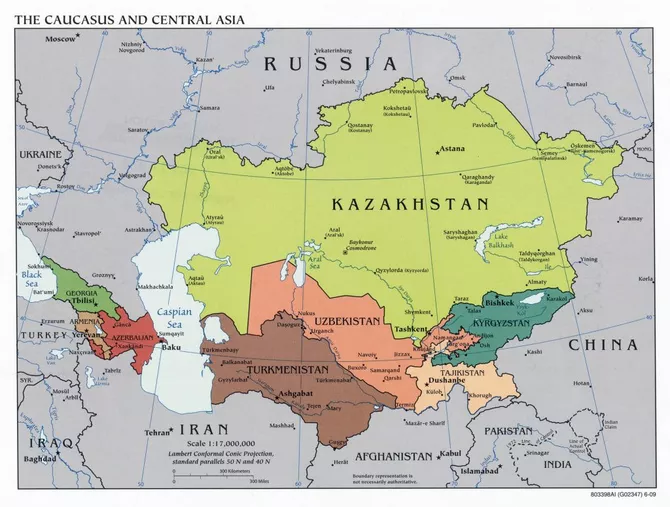
photo: NBC News
In recent years, trade and transit flows along the Trans-Caspian International Transport Route (TITR), better known as the Middle Corridor, have demonstrated remarkable growth. This route connects China and Europe through Central Asia, the Caspian Sea, the South Caucasus, and Türkiye, offering an alternative overland route for cargo shipments. Its rapid development has become particularly relevant against the backdrop of global geopolitical shifts, supply chain disruptions, and sanctions pressure that have reshaped traditional trade routes. A key factor driving this growth has been the integration of Chinese freight within the framework of the Belt and Road Initiative (BRI), which has increased global attention to the route and stimulated investment in the infrastructure of participating countries, including Azerbaijan.
The Middle Corridor is increasingly seen as a viable alternative to traditional routes, such as those passing through Russia or maritime shipments via the Suez Canal. Its main advantage lies in the speed of delivery: cargo transportation from China to Europe via this route takes an average of 20-25 days, nearly twice as fast as the 40-50 days required for shipments via the Suez Canal. This time advantage makes the route particularly attractive for producers and exporters seeking to reduce logistics costs and accelerate supply chains. Consequently, cargo volumes through the Middle Corridor have surged by almost 90% since 2022. In 2024 alone, 358 container block trains traveled along this route, and forecasts suggest this figure could triple in the coming years as global players increasingly seek alternatives to congested and politically sensitive routes.

photo: RUSI
For China, the Middle Corridor holds strategic importance. Amid rising political risks and intensifying global competition, Beijing is focused on diversifying its logistics chains and reducing dependency on routes vulnerable to blockades or military conflicts. The South Caucasus, and especially Azerbaijan, play a pivotal role in this strategy. Chinese companies are steadily increasing the number of container block trains passing through Central Asia, the Caspian Sea, and Azerbaijani territory. In the medium term, plans call for more than 1,000 trains to travel annually along this route, underscoring the region’s growing significance in ensuring stable trade links between Asia and Europe.
Azerbaijan’s geographic position at the intersection of the East-West and North-South transport corridors gives it a central role in the Middle Corridor’s development. In recent years, the country has invested heavily in upgrading its transportation infrastructure, including railways, ports, and logistics hubs. The Baku International Sea Trade Port has emerged as a vital hub for transshipment, connecting the railway networks of Central Asia and the South Caucasus. Modern multimodal terminals have been established to accelerate container handling and improve the route’s competitiveness. As part of its cooperation with China, Azerbaijan has initiated discussions on digitalizing logistics processes, including the creation of a joint working group between the port of Ningbo and the Baku port to promote automation and advanced management technologies.
One of the most critical infrastructure projects within the Middle Corridor is the Zangezur Corridor, which will connect the railway networks of Azerbaijan and Türkiye via the Nakhchivan Autonomous Republic, providing seamless access to European transportation systems. The construction of the Goradiz-Agbend railway line, spanning 110.4 kilometers, is progressing rapidly, with 76 kilometers already completed. In parallel, Türkiye is constructing a 224-kilometer section between Kars and Dilucu. Upon completion of all segments, the corridor’s total freight capacity could reach 15 million tons annually, significantly strengthening the region’s transit potential and positioning it as a major hub for Eurasian logistics.
The Middle Corridor has become a topic of increasing interest in global political and business circles. In August, negotiations were held in Washington, where, under the mediation of U.S. President Donald Trump, the Prime Minister of Armenia and the President of Azerbaijan reached agreements on advancing regional connectivity under the “Trump’s Route for International Peace and Prosperity” (TRIPP) project. This initiative aims to establish stable cross-border infrastructure that will facilitate uninterrupted trade flows while enhancing economic stability across the South Caucasus. During subsequent meetings with U.S. business representatives, the diversification of trade and energy supply chains was emphasized, alongside the critical role Azerbaijan plays as a transport and logistics hub bridging Europe and Asia.
The United States views the Middle Corridor not only as an economic project but also as a geopolitical instrument. For Washington, supporting this route offers an opportunity to bolster the positions of its allies in the region and reduce the dominance of other powers over traditional trade routes, particularly Russia. U.S. involvement could also accelerate the adoption of cutting-edge technologies, enhance transparency, and create favorable conditions for foreign investors.

photo: CABAR.asia
Nevertheless, the development of the Middle Corridor faces a series of serious challenges. Despite its faster delivery times, transportation costs along this route remain higher than those of maritime shipments, reducing its competitiveness. To address this, participating countries must harmonize tariffs, standardize regulations, and adopt digital solutions to streamline logistics processes. Without such measures, the corridor risks inefficiencies and fragmentation. Moreover, political instability remains a significant concern. Both the South Caucasus and Central Asia are regions prone to internal and external conflicts, which could undermine investor confidence and disrupt trade flows.
The Middle Corridor also faces competition from well-established routes. Northern rail corridors through Russia continue to benefit from advanced infrastructure and longstanding logistical systems, while the Suez Canal remains the most cost-effective shipping option in times of global stability. For the corridor through Azerbaijan and the South Caucasus to solidify its role, substantial investment in infrastructure must be coupled with political coordination among participating nations and the creation of long-term partnerships with external stakeholders.
An essential next step will be the establishment of a unified digital management platform for Middle Corridor operations. Such a system would improve transparency, reduce corruption risks, and enhance operational efficiency. Azerbaijan, with its advanced IT capabilities, is well-positioned to play a central role in this digital transformation, strengthening its status as both a logistical and technological hub for the region.
The evolution of the Middle Corridor reflects broader transformations in global trade and geopolitics. As protectionism rises and competition for control over trade flows intensifies, Eurasian nations and their international partners are striving to diversify transportation routes and reduce reliance on traditional transit paths. In this context, Azerbaijan is emerging not merely as a transit point but as a key player in shaping a new architecture of international economic relations.
The future of the Middle Corridor will depend on how effectively participating countries can coordinate their strategies and overcome existing challenges. If Azerbaijan, China, Türkiye, and other major stakeholders succeed in building a cohesive vision, the route has the potential to become one of the world’s leading trade arteries in the 21st century, offering new opportunities for sustainable economic growth and regional cooperation. Conversely, without such coordination, the corridor risks remaining a secondary alternative, overshadowed by more established global routes. Amid ongoing geopolitical turbulence, the Middle Corridor serves as a vital indicator of shifting power balances in global trade and illustrates how Azerbaijan and other regional states are adapting to the challenges of an evolving world order.
By Samir Muradov
Share on social media